
The Dean Cemetery is a historically important Victorian cemetery north of the Dean Village, west of Edinburgh city centre, in Scotland. It lies between Queensferry Road and the Water of Leith, bounded on its east side by Dean Path and on its west by the Dean Gallery. A 20th-century extension lies detached from the main cemetery to the north of Ravelston Terrace. The main cemetery is accessible through the main gate on its east side, through a "grace and favour" access door from the grounds of Dean Gallery and from Ravelston Terrace. The modern extension is only accessible at the junction of Dean Path and Queensferry Road.

George Square is the principal civic square in the city of Glasgow, Scotland. It is one of six squares in the city centre, the others being Cathedral Square, St Andrew's Square, St Enoch Square, Royal Exchange Square, and Blythswood Square on Blythswood Hill.

Charles Erskine also spelled Areskine, of Tinwald and Barjarg, Dumfries, and Alva, Clackmannan was Lord Advocate, a Scottish judge, and a politician who sat in the House of Commons from 1722 to 1742.
The New Town is a central area of Edinburgh, the capital of Scotland. It was built in stages between 1767 and around 1850, and retains much of its original neo-classical and Georgian period architecture. Its best known street is Princes Street, facing Edinburgh Castle and the Old Town across the geological depression of the former Nor Loch. Together with the West End, the New Town was designated a UNESCO World Heritage Site alongside the Old Town in 1995. The area is also famed for the New Town Gardens, a heritage designation since March 2001.

Arniston House is a historic house in Midlothian, Scotland, near the village of Temple. This Georgian mansion was designed by William Adam in 1726 for Robert Dundas, of Arniston, the elder, the Lord President of the Court of Session. The western third of the house was added by John Adam, son of William and brother of Robert Adam, in 1753.

Greyfriars Kirkyard is the graveyard surrounding Greyfriars Kirk in Edinburgh, Scotland. It is located at the southern edge of the Old Town, adjacent to George Heriot's School. Burials have been taking place since the late 16th century, and a number of notable Edinburgh residents are interred at Greyfriars. The Kirkyard is operated by the City of Edinburgh Council in liaison with a charitable trust, which is linked to but separate from the church. The Kirkyard and its monuments are protected as a category A listed building.

Dundas House is a Neoclassical building in Edinburgh, Scotland. It is located at 36 St Andrew Square, in the city's first New Town. The building was completed in 1774 as a private town house for Sir Lawrence Dundas by the architect Sir William Chambers. Much altered internally and extended over the years, today it is the registered office of the Royal Bank of Scotland and its parent, NatWest Group and is protected as a category A listed building.
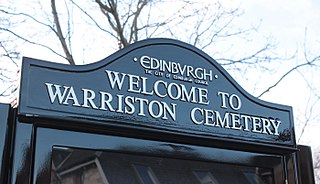
Warriston Cemetery is a cemetery in Edinburgh. It lies in Warriston, one of the northern suburbs of Edinburgh, Scotland. It was built by the then newly-formed Edinburgh Cemetery Company, and occupies around 14 acres (5.7 ha) of land on a slightly sloping site. It contains many tens of thousands of graves, including notable Victorian and Edwardian figures, the most eminent being the physician Sir James Young Simpson.
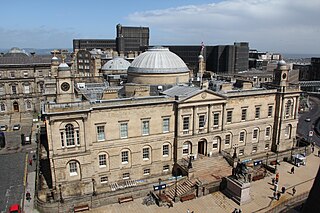
General Register House is an Adam style neoclassical building on Princes Street, Edinburgh, purpose built by Robert Adam between 1774 and 1788 as the headquarters of the National Archives of Scotland. It is a Category A listed building.

Patrick Small Keir Newbigging FRSE FRSSA FRCSE (1813–1864) was a Scottish surgeon and general practitioner. He was President of the Royal Medical Society and of the Royal Scottish Society of Arts. Together with his father, Sir William Newbigging he formed one of the few father-son pairs of former Presidents of the Royal College of Surgeons of Edinburgh. His observations on the origin of the heart sounds and of the apex beat of the heart made a significant contribution to the debate.
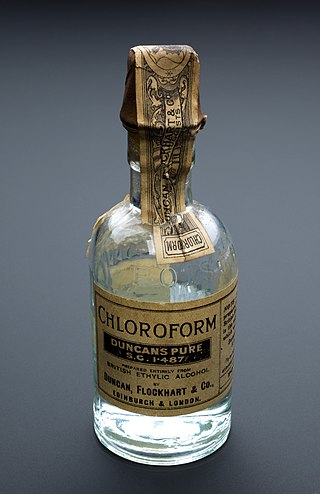
James Duncan FRSE FRCS FRCSE was a Scottish surgeon and manufacturing chemist responsible for much of the British supply of chloroform in the mid-19th century. From 1839 to 1866 he was Director of Duncan Flockhart & Co one of Scotland’s largest chemical manufacturers.
William John Dundas, FRSE, LLD, WS (1849–1921) was a Scottish lawyer and mathematician. In later life he was a director of the Royal Bank of Scotland. He was the younger brother of James Dundas VC.
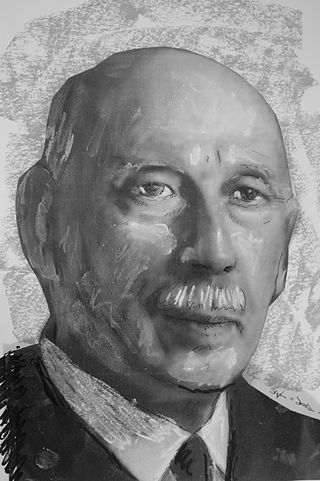
Sir William Campbell Johnston FRSE was a Scottish lawyer and noted cricketer.
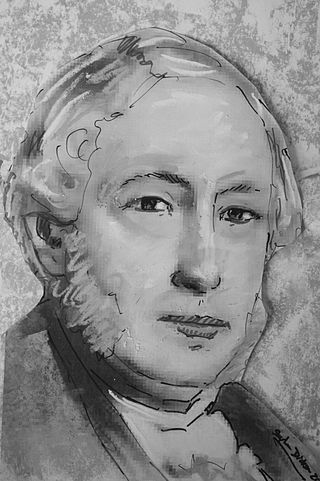
Sir William Newbigging was a Scottish surgeon who served as President of the Royal College of Surgeons of Edinburgh from 1814 to 1816. He was a keen amateur geographer.

Royal Terrace is a grand street in the city of Edinburgh, Scotland, on the north side of Calton Hill within the New Town and part of the UNESCO World Heritage Site inscribed in 1995, built on the south side of a setted street, facing the sloping banks of London Road Gardens, formerly Royal Terrace Gardens, with views looking north towards Leith and the Firth of Forth.

The Moray Estate, also known as the Moray Fey, is an early 19th century building venture attaching the west side of the New Town, Edinburgh. Built on an awkward and steeply sloping site, it has been described as a masterpiece of urban planning.

Carlton Terrace is a residential street in Edinburgh, Scotland. It is located on the east side of Calton Hill, at the eastern extremity of the New Town, part of the UNESCO World Heritage Site inscribed in 1995.

Queen Street is the northernmost east-west street in Edinburgh's First New Town. It begins in the east, at the Scottish National Portrait Gallery. It links York Place with the Moray Estate.
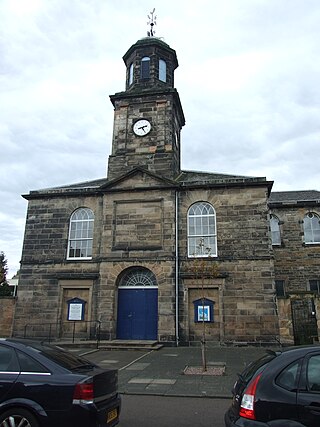
William Sibbald (c.1760–1809) was a Scottish architect. He was superintendent of public works in Edinburgh and assisted Robert Reid in setting out and designing the Second New Town.
Peter Spalding (1758–1826) was a Scottish colonial trader and philanthropist.























